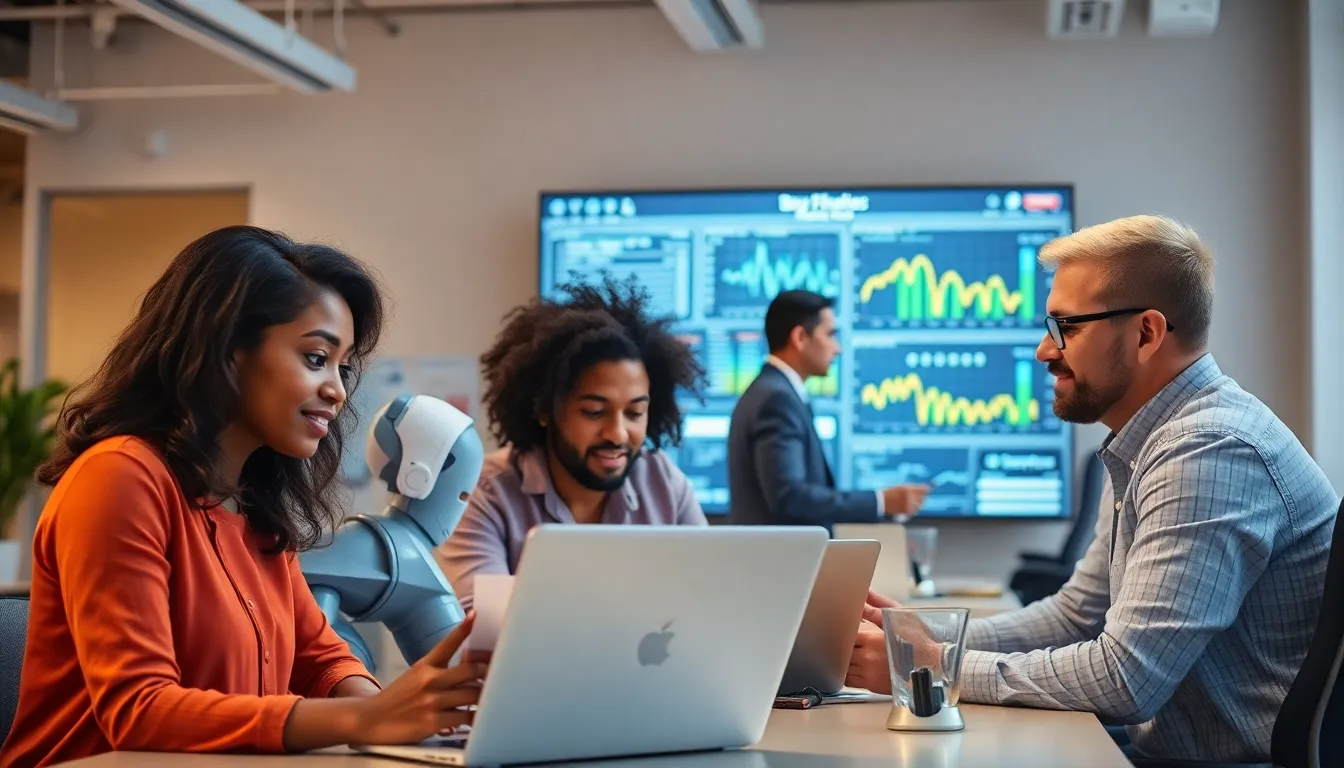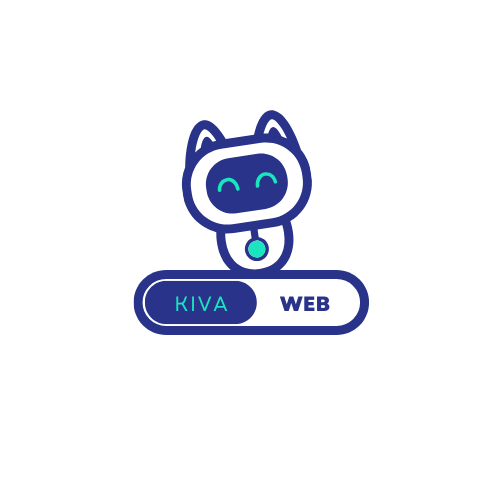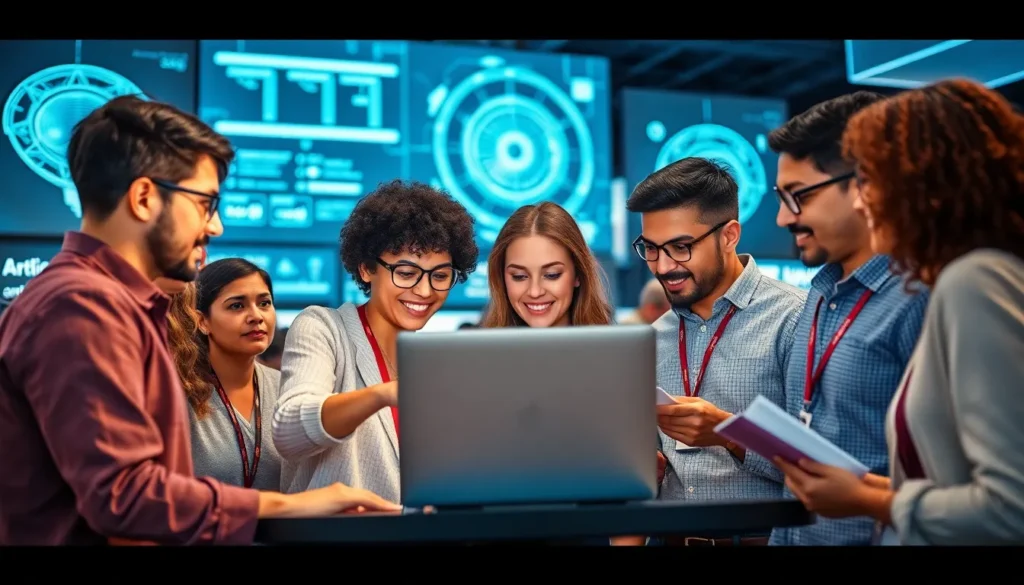In a world where artificial intelligence is no longer just a sci-fi dream, the AI community is buzzing louder than a caffeinated robot on a coding spree. This vibrant network of enthusiasts, developers, and thinkers is where innovation meets collaboration, and the possibilities are endless. Whether you’re a seasoned pro or just dipping your toes into the AI pool, there’s a place for everyone in this digital playground.
Table of Contents
ToggleOverview of the AI Community
The AI community thrives on collaboration and shared knowledge. Engaging with others fosters innovation and growth. Developers create diverse tools and applications, pushing boundaries in various industries. Enthusiasts contribute insights through blogs, forums, and meetups. Thinkers analyze trends and provide thoughtful discussions on the ethical implications of AI technology.
In recent years, online platforms like GitHub and Stack Overflow have become essential for knowledge exchange. Individuals participate in open-source projects, enhancing their skills while supporting larger initiatives. Hackathons frequently collect diverse talents, encouraging teamwork to solve real-world problems using AI.
Global conferences draw experts and newcomers alike, showcasing the latest advancements. Networking opportunities arise during these events, allowing sharing of experiences and ideas. Communities form around specific interests, such as machine learning, natural language processing, or robotics, resulting in vibrant ecosystems.
Learning resources abound, including online courses, webinars, and tutorials. Individuals looking to improve their skills find support from experienced mentors willing to share their expertise. Resources are accessible, catering to learners at all stages, whether just starting or looking to deepen their knowledge.
Ultimately, the AI community embodies inclusiveness. It encourages a diverse range of participants to explore, innovate, and collaborate within the digital landscape. With such a dynamic environment, the AI community continually adapts and evolves.
Key Players in the AI Community

The AI community comprises a diverse group, including industry leaders and academic institutions that drive innovation and research.
Industry Leaders
Tech giants like Google, Microsoft, and Amazon spearhead advancements in AI technology, offering tools that power global applications. These organizations invest heavily in research initiatives, contributing to breakthroughs in machine learning and natural language processing. Companies such as Nvidia enhance hardware capabilities, enabling more efficient AI computations. Startups also play a crucial role, introducing innovative solutions and fresh perspectives. Their agile approaches often lead to rapid developments, pushing the boundaries of what’s possible with artificial intelligence.
Academic Institutions
Universities like Stanford, MIT, and Carnegie Mellon rank among the foremost contributors to AI research. They produce groundbreaking studies that shape the theoretical foundations of artificial intelligence. Collaborative projects often emerge from these institutions, engaging interdisciplinary teams to tackle complex problems. Many academic programs also offer specialized courses that prepare students for careers in AI. Partnerships with industry leaders facilitate knowledge transfer, ensuring alignment between research and real-world application. These collaborations foster an environment ripe for exploration, ultimately contributing to the evolution of AI technologies.
Major Contributions of the AI Community
The AI community significantly drives research and innovation. These contributions span numerous industries, shaping advancements that redefine technology.
Research Advancements
Innovative techniques continuously emerge from collaborative research within the AI community. Prominent institutions like Stanford, MIT, and Carnegie Mellon lead studies that push the boundaries of machine learning and neural networks. Publications in journals cultivate academic discourse and disseminate knowledge across the globe. Researchers share datasets and methodologies through platforms like arXiv, allowing for reproducibility and validation of findings. The growing interest in ethical AI prompts research into responsible practices and bias mitigation, providing crucial insights that guide development. Moreover, advancements in natural language processing and computer vision reshape the landscape, enhancing applications in daily life and various sectors.
Open Source Projects
Open source projects foster an inclusive environment for innovation and collaboration. Platforms such as GitHub host countless projects, enabling developers to contribute and share code. Communities form around popular frameworks like TensorFlow and PyTorch, where individuals enhance tools and create powerful applications together. Hackathons and coding events encourage teamwork, prompting solutions for real-world challenges. Moreover, comprehensive documentation and tutorials support newcomers, empowering them to participate actively. The collaborative nature of open source projects accelerates learning and fosters creativity, making contributions accessible to all skill levels within the AI community.
Challenges Facing the AI Community
The AI community faces several significant challenges. These hurdles require collective focus and innovative solutions.
Ethical Considerations
Ethical considerations stand as a primary concern within the AI landscape. Developers often grapple with issues like bias in algorithms and privacy violations. Transparency in AI systems is crucial to building trust among users. Organizations increasingly prioritize the development of responsible AI practices. Guidelines from entities like the IEEE and AI Now Institute shape discussions about ethical frameworks. Stakeholders must engage in conversations that address the potential consequences of AI applications. Regular assessments of AI’s impact on society help mitigate harm. Addressing these considerations ensures the technology benefits everyone equitably.
Collaboration Barriers
Collaboration barriers hinder progress in the AI community. Competition among companies sometimes leads to siloed information and limited knowledge sharing. Intellectual property concerns can create reluctance among developers to share innovations. Geographic distance isolates teams, making communication and teamwork more challenging. Language differences further complicate collaboration across global teams. Efforts to standardize tools and platforms may improve ease of use. Encouraging partnerships across sectors can streamline cooperation. Overcoming these barriers enhances the community’s collective ability to innovate and tackle complex problems.
Future of the AI Community
The future of the AI community focuses on continuous growth and adaptation. Innovations in technology promise to revolutionize industries, and communities will expand to include a more diverse range of participants. Collaboration among enthusiasts, developers, and researchers promotes a culture of knowledge sharing, which will likely strengthen as the industry evolves.
Ethical considerations will remain a priority. With advancements comes the responsibility to address potential biases and privacy concerns. Organizations like the IEEE and AI Now Institute lead efforts to establish ethical frameworks designed to ensure technology benefits everyone equitably. Transparent practices foster user trust and enhance the community’s credibility.
Emerging technologies will influence learning methodologies. Individuals might access an increasing array of online courses, webinars, and workshops tailored to various skill levels. This abundant knowledge base supports the ongoing education of newcomers and experts alike. Mentor relationships may flourish, providing guidance and insight into evolving trends within the AI field.
Global networking opportunities are set to grow. Conferences focused on machine learning, robotics, and other subfields will facilitate connections among like-minded professionals. Countries across the world will likely host events that celebrate achievements and innovations, forging partnerships essential for tackling complex challenges.
Startups and established tech giants will continue to collaborate on innovative projects. Joint ventures may leverage the strengths of each sector while addressing immediate needs within the market. Academic institutions, such as Stanford and MIT, will collaborate with industry leaders, aligning research with practical application to shape the next wave of AI technology.
Challenges will undoubtedly persist, and the community must navigate these barriers to synergy. Competition may arise among organizations, and intellectual property concerns could surface. Addressing these issues proactively is crucial to maintaining a collaborative spirit and fostering a vibrant AI community.
Conclusion
The AI community stands as a testament to the power of collaboration and shared vision. Its inclusive nature invites individuals from all backgrounds to participate and contribute to groundbreaking advancements. As ethical considerations and innovative technologies shape the future, the community’s commitment to responsible practices will be vital in ensuring that AI benefits everyone.
With ongoing opportunities for networking and collaboration, the AI community is poised for continued growth. The blend of insights from industry leaders and academic institutions fosters an environment ripe for exploration. Challenges may arise but the collective drive for innovation will undoubtedly lead to transformative solutions that address the complexities of tomorrow.










